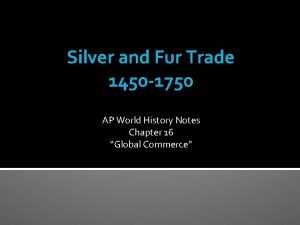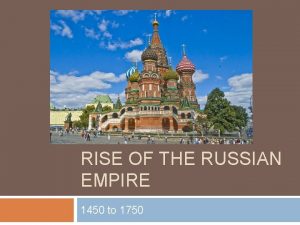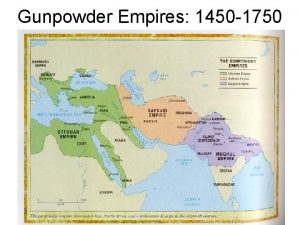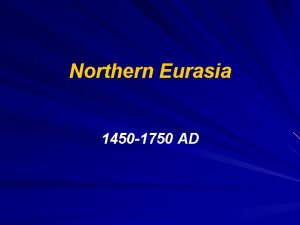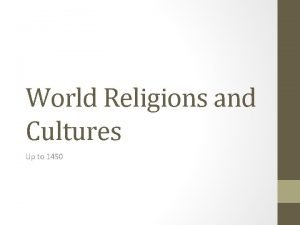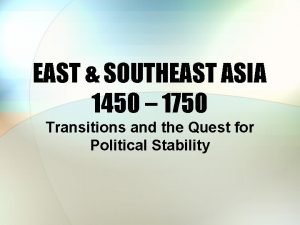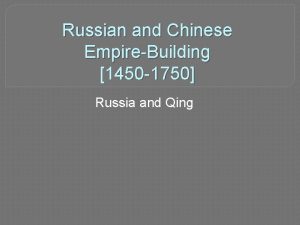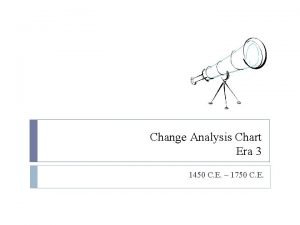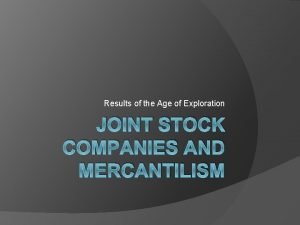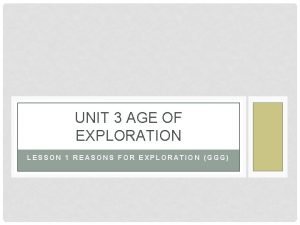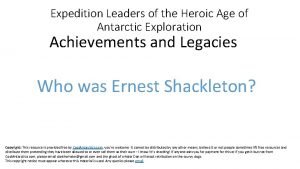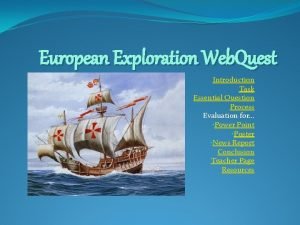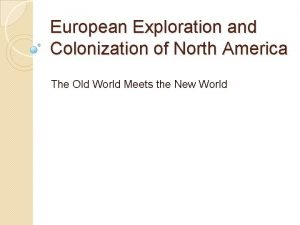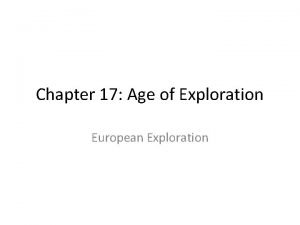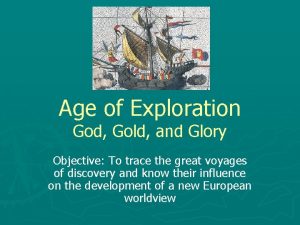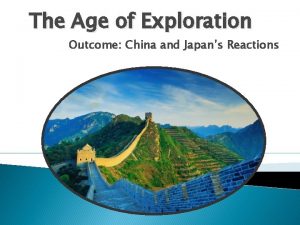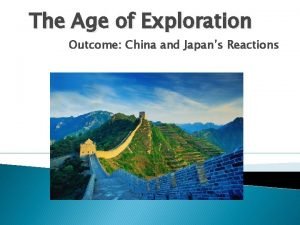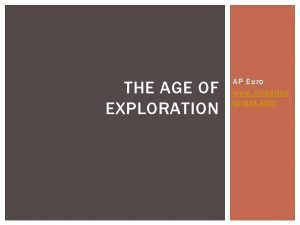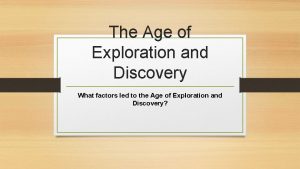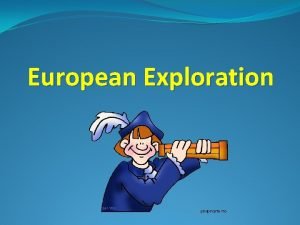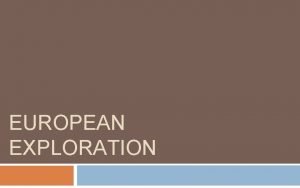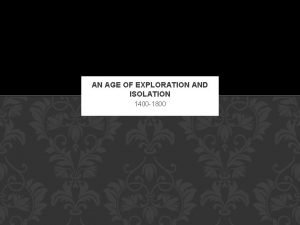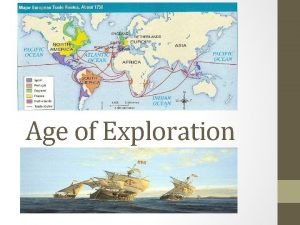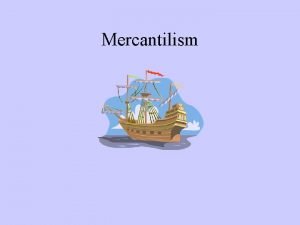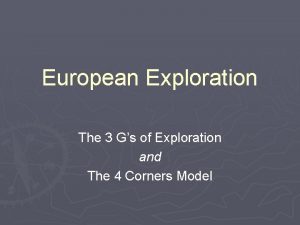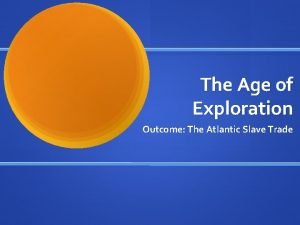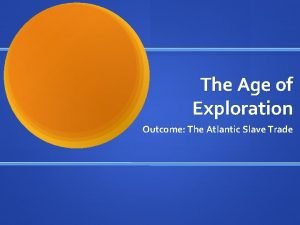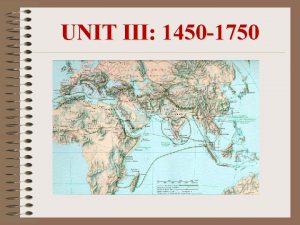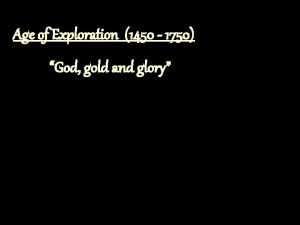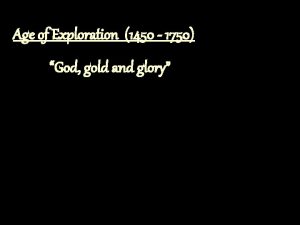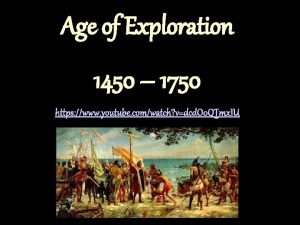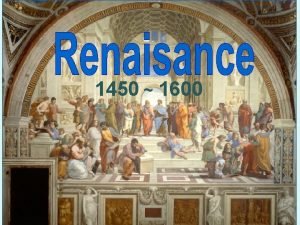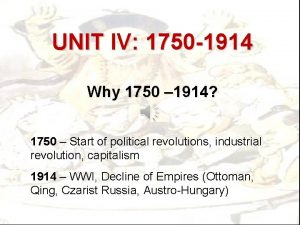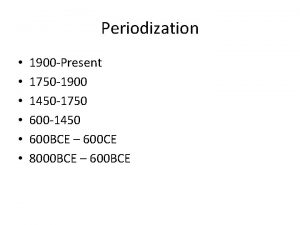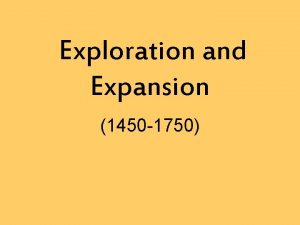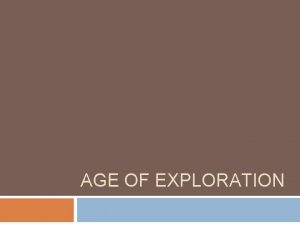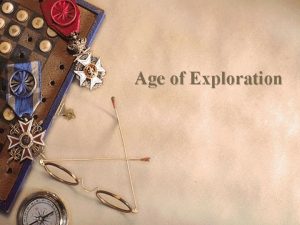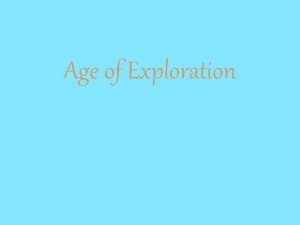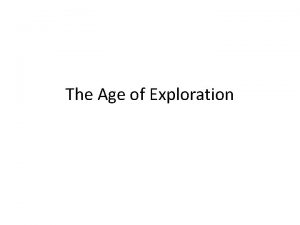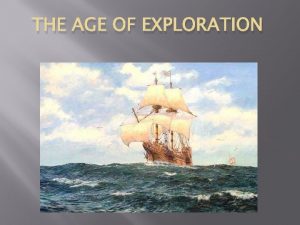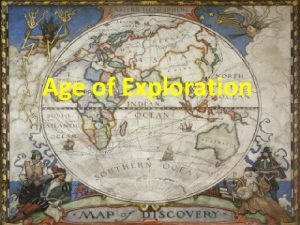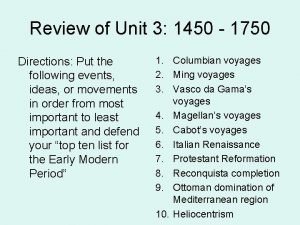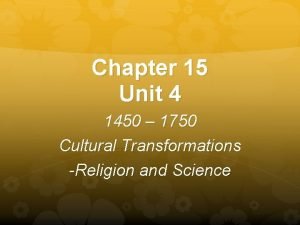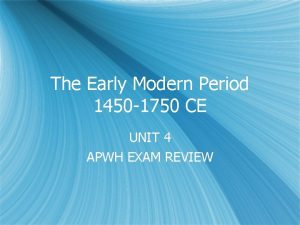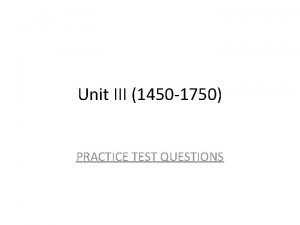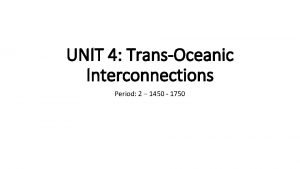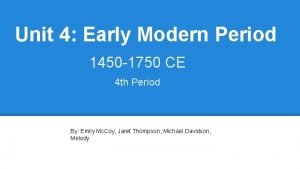Unit 4 1450 1750 Age of Exploration The


































- Slides: 34

Unit 4: 1450 -1750 Age of Exploration: The Hemispheres Unite!

Big Picture- Period 4 • Transatlantic connections • • First time we can talk about “world” history VAST expansion of interregional exchange • COLUMBIAN EXCHANGE • New labor systems • Maritime and land-based (“gunpowder”) empires • Europe’s time to shine

Globalizing networks of communication & exchange • China: Zheng He - last great explorer (1371 -1433) • • • Could have been 1 st to discover Americas Ming Dynasty pulls inward, rejects exploration Europe: big man on campus • • Goes to Africa, Asia, Americas Beginning of European colonization



Factors that led to European expansion • Advances in technology • • • Need to expand trade routes • • New tools from Asia (astrolabe, magnetic compass, better maps) New ship designs (caravel) Fall of Constantinople to Ottomans in 1453 = bad news for Christian traders Religious motivations • • Protestant Reformation in 1517 Catholic rulers want to expand Catholicism

Why Portugal and Spain First? - Located near ocean - Need to get around Italian grip on Mediterranean - Go west and south!

Portugal Goes South • 1418: Prince Henry the Navigator starts a school to teach navigators to sail down west coast of Africa • 1488: Bartolomeo Dias sails around Cape of Good Hope • 1498: Vasco de Gama reaches India by ocean (1 st European) • Kongo, Angola, and Swahili City States all fall to Portuguese rule

Spain Goes West • Christopher Columbus really wants to find glory at sea • Thinks he can sail west to reach Asia (India) • Basically everyone else in the world thinks he’s an idiot • King Ferdinand Queen Isabella say “eh, why not? ” • October 12, 1492: Lands somewhere in Caribbean • Discovers gold on island of Hispaniola- ensures Spaniards will be back

Spain in Americas • Conquer Aztecs and Incas • • 1521: Hernan Cortes- Aztecs 1532: Francisco Pizarro- Incas Both men used gunpowder, horses, disease and disgruntled locals to overthrow massive empires *** Columbian Exchange *** • Crash course video


Europe Goes East • Everyone wants in on the Asian game • Trade American gold & silver for Asian goods • Joint-stock companies formed • • • British East India Company – 1600 Dutch East India Company – 1602 Dutch West India Company- 1621 French East India Company- 1664 **Mercantilism**- main economic system in Period 4 • • You want a positive flow of wealth into your country Zero-sum game with other countries

Spread and Blend of Religions • Christianity spread through Asia and Americas • Syncretic religions: • • • Vodun (vodou) in Caribbean Cult of saints in Latin America Sikhism

Innovations in Art • Renaissance • • • Italian merchants who were rich off trade could afford to pay artists to make art Renaissance is born Innovations in art (1 -point linear perspective, depth, anatomy, engineering, etc)

New forms of social organization and modes of production • Social organization • • Family size and composition Social classes change New races of people creates Modes of production • Expanded trade & Columbian exchange = big changes

Intensification of peasant labor • Indian production of cotton goods • • • Russian peasants • • • East India Company – 1690 s Cultivation & production in West India Settle Siberia Serfdom Europe- putting-out system

Coerced Labor • Chattel slavery • • Indentured servitude • • Europeans brought for ~ 7 year terms Encomienda and hacienda system • • Africans imported to Americas Labor in exchange for protection and Christian instruction Mit’a

Existing Elites- Daimyo • • Japanese equivalent to European nobility Enjoyed great freedom until Tokugawa period or Edo Period (1603 -1868) • Tokugawa shogunate reined in daimyo • Laws restricting: dress, behavior, marriage, weaponry, etc • Forced to live in Edo (capital) every other year • Forced to contribute to public works projects

New Elites- Manchus in China • Manchu people • • • Northeastern China Mix of Jurchen, Mongolian, and Han Chinese Manchu (Qing) Dynasty • • Conquer Ming Dynasty between 1644 and 1673 Took over government Ethnic minority takes over Chinese government Adopted Confucianism and Mandate of Heaven

Gender & Family Restructuring • European men depend on Southeast Asian women for trade in that region (Malay Peninsula, Indonesia, Philippines) • Matriarchal societies • • • Wealth passed from man to woman in marriage Women were educated, allowed to engage in finance Trade run by women • • • Women worked outdoor markets Engaged in long-distance trade Wealthiest women controlled mini trade empires

New Ethnic and Racial Classifications • Peninsulares- Iberian Spaniards • Criollos- Descendents of Peninsulares • Mestizos- European/Native American • Mulattoes- European/African • Native Americans • Slaves

Period 4 is not “all Atlantic, all the time” Continuities in the Global Networks of Exchange

Continuities in Religion • Islam continues its spread across Sub. Saharan Africa and into East and Southeast Asia (Indonesia and Philippines) • Buddhism moves across SE Asia and into parts of Central Asia • Hinduism is core in India

Continuities in Trade • Indian Ocean trade continued to thrive • European merchants could only joined if they cooperated with the local rulers of the port cities because they couldn’t dominate this long-established organization • Atlantic trade volume eventually surpassed the Indian Ocean trade

Continuities in Agriculture • Most people in the world were STILL farmers – most growing just enough for their families to live on with a little left over to sell • Others grew a single crop to be exported for food (initial commercial farming) • Changes occurred because of the flood of new foods from the Americas

Continuities in Migrations • Just before 1492 most mass migrations had ended • Hawaii inhabited by 900 • Tahiti by c 1300 • Bantu Migration near end – built Great Zimbabwe


Review Questions

The “Monument of the Discoveries” designed for the 1940 World’s Fair in Lisbon, Portugal shown in the picture above uses monumental architecture to reflect national pride in A. Zheng He’s voyages in the Indian Ocean which enhanced Chinese prestige. B. Prince Henry’s school of navigation that led to increased travel and trade in Africa. C. Columbus’ journey to the Caribbean which began the process of imperialism in the Americas. D. John Cabot’s explorations of the North Atlantic and journey to what is now modern Canada.

This engraving by a German artist depicts a Ming Dynasty currency called a “tael” that was produced with metals acquired from the newly opened Spanish colonial mines. The engraving best illustrates which of the following features of 18 th century economic trade? A. Joint-Stock Companies B. The Columbian Exchange C. Global Circulation of Silver D. Japanese Daimyos

Which of the following historical cultural developments was a direct consequence of the trade networks seen in the map above? A. Renaissance art in Europe B. Spread of Islam to new regions C. The Protestant Reformation D. Syncretic religions of the Caribbean

The portrait of Louis Francois Roger Armand Gatereau, a French newspaper editor, on the island of Saint Dominique would best be used by a historian to demonstrate which of the following changes caused by global interactions during the latter eighteenth century? A. Transformations in diets that resulted from the Columbian Exchange. B. Innovations in visual art during the time of the Renaissance. C. Restructuring of gender and racial relationships in elite society. D. Emergence of challenges to French imperial control of colonial society.

LEQ: Prompt: Discuss the similarities and differences between the reactions of the Russian and Japanese political elite to the West/Westerners from 1450 - 1750.

LEQ: Prompt: Discuss the changes and continuities between the first age of overseas expansion in the 16 th century and the second age of overseas expansion in the 19 th century. Discuss the impact on ONE of the following areas: Africa South Asia The Americas East Asia
 Mughal empire 1450 to 1750
Mughal empire 1450 to 1750 Silver trade 1450 to 1750
Silver trade 1450 to 1750 Russian empire innovations 1450 to 1750
Russian empire innovations 1450 to 1750 Land based empires 1450 to 1750
Land based empires 1450 to 1750 Japan 1450-1750
Japan 1450-1750 Religion 1450-1750
Religion 1450-1750 Southeast asia 1450 to 1750
Southeast asia 1450 to 1750 Splitski nadbiskup 1450
Splitski nadbiskup 1450 Change analysis chart 1450 to 1750
Change analysis chart 1450 to 1750 Stone age, bronze age iron age timeline
Stone age, bronze age iron age timeline Iron age bronze age stone age timeline
Iron age bronze age stone age timeline Joint-stock companies during the age of exploration
Joint-stock companies during the age of exploration The age of exploration lesson 1
The age of exploration lesson 1 Age of exploration diagram
Age of exploration diagram Age of exploration videos
Age of exploration videos Heroic age of antarctic exploration
Heroic age of antarctic exploration Age of exploration webquest
Age of exploration webquest Jacques cartier legacy
Jacques cartier legacy Age of exploration motives
Age of exploration motives Age of exploration glory
Age of exploration glory Pineda explorer route
Pineda explorer route The age of exploration outcome china and japan's reactions
The age of exploration outcome china and japan's reactions The age of exploration outcome china and japan's reactions
The age of exploration outcome china and japan's reactions Martin behaim
Martin behaim What factors led to the age of exploration
What factors led to the age of exploration Age of exploration jeopardy
Age of exploration jeopardy God gold glory drawing
God gold glory drawing “god, glory, gold”
“god, glory, gold” Saq-14
Saq-14 Dutch exploration routes
Dutch exploration routes The age of exploration definition
The age of exploration definition Mercantilism during the age of exploration
Mercantilism during the age of exploration 3 gs of exploration
3 gs of exploration The age of exploration outcome the atlantic slave trade
The age of exploration outcome the atlantic slave trade The age of exploration outcome the atlantic slave trade
The age of exploration outcome the atlantic slave trade

